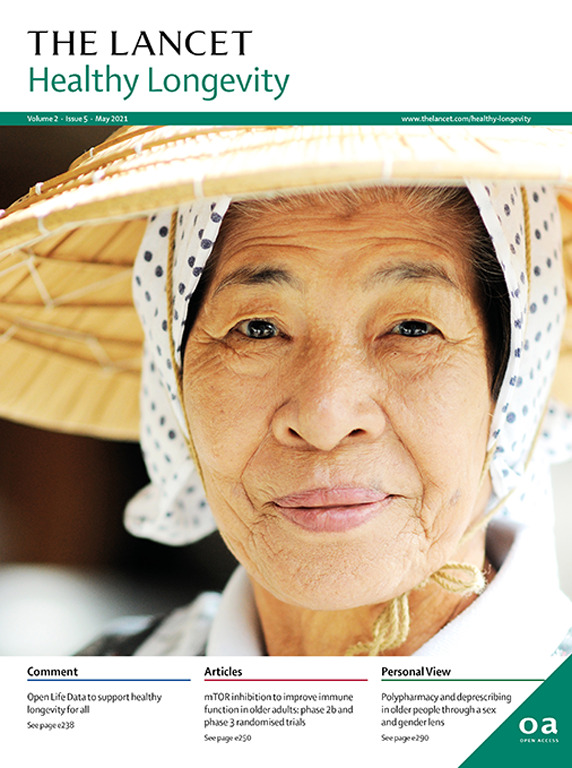英国无家可归者中虚弱的患病率和相关的社会经济因素:健康需求调查数据的横断面二级分析
IF 14.6
Q1 GERIATRICS & GERONTOLOGY
引用次数: 0
摘要
背景:虚弱是一种影响多个身体系统的复杂健康状态,导致对健康压力源的易感性增加。与一般人群相比,无家可归者的健康状况较差,包括体弱多病的发生率较高。本研究旨在计算英格兰PEH患者的虚弱患病率,并探讨相关的社会人口学特征。方法:本研究对英国PEH的健康需求数据进行了横断面、二次分析研究,采用改进的德尔菲法寻求专家意见,并遵循已发表的脆弱性指数构建指南,创建了脆弱性指数。无家可归者链接在2012年至2021年期间,分三波通过访谈者亲自进行的调查收集了主要城市地区的数据。具有至少80%虚弱指数变量数据的参与者被纳入研究。描述性统计总结了人口情况。在虚弱指数数据充足的参与者中,计算虚弱患病率(虚弱指数得分在0.25及以上)和虚弱前患病率(虚弱指数得分在0.08至0.25之间)。使用多项逻辑回归(调整了年龄、性别、调查时的住宿、就业、志愿服务和教育的参与以及移民身份)探讨了虚弱和社会人口特征之间的关系。结果:研究样本包括2288例PEH(2156例[94.2%],年龄18-59岁)。研究人群中有949人(41.5%)普遍虚弱,1001人(43.8%)处于虚弱前期。789例18-29岁PEH中有210例(26.6%)虚弱。50-59岁PEH的衰弱风险是18-29岁PEH的8倍以上(校正风险比8.30,95% CI 4.86 - 14.16)。经历过无家可归的女性(2.30,1.57 - 3.37)和不从事就业、志愿服务和教育的PEH(3.05, 1.97 - 4.71)也比经历过无家可归的男性和从事这些活动的PEH有更高的虚弱风险。非英国籍PEH患者的衰弱风险低于英国籍PEH患者(0.20,0.12 - 0.33)。与以前无家可归但现在有住所的人相比,睡在户外的人更容易虚弱(0.36,0.17 - 0.76)。类似的模式在虚弱前也被观察到。解释:据我们所知,这是PEH中最大规模的脆弱性研究,为这一弱势群体的非老年脆弱性高水平提供了有价值的见解,可以作为指导这一人群的服务开发和政策的起点。资助:国家卫生和保健研究所。本文章由计算机程序翻译,如有差异,请以英文原文为准。
Prevalence of frailty and associated socioeconomic factors in people experiencing homelessness in England: cross-sectional secondary analysis of health needs survey data
Background
Frailty is a complex health state affecting multiple body systems, resulting in increased vulnerability to health stressors. People experiencing homelessness (PEH) have poorer health, including higher prevalence of frailty, than the general population. This study aimed to calculate prevalence of frailty in PEH in England and explore associated sociodemographic characteristics.
Methods
This cross-sectional, secondary analysis study of health needs data collected from PEH in England created a frailty index by seeking expert input using a modified Delphi method and following published guidance for frailty index construction. Data were collected by Homeless Link in primarily urban areas through in-person, interviewer-administered surveys between 2012 and 2021 in three waves. Participants with data for at least 80% of frailty index variables were included. Descriptive statistics summarised the population. Among participants with sufficient frailty index data, the prevalence of frailty (frailty index scores of 0·25 or more) and pre-frailty (scores between 0·08 and 0·25) was calculated. Associations between frailty and sociodemographic characteristics were explored using multinomial logistic regression (adjusted for age; gender; accommodation at time of survey; engagement in employment, volunteering, and education; and immigration status).
Findings
The study sample included 2288 PEH (2156 [94·2%] aged 18–59 years). Frailty was prevalent in 949 (41·5%) of the study population and pre-frailty in 1001 (43·8%). Frailty was identified in 210 of 789 (26·6%) PEH aged 18–29 years. PEH aged 50–59 years had over eight times higher risk of frailty compared with PEH aged 18–29 years (adjusted risk ratio 8·30, 95% CI 4·86–14·16). Women experiencing homelessness (2·30, 1·57–3·37), and PEH who were not engaged in employment, volunteering, and education (3·05, 1·97–4·71) also had higher risk of frailty than men experiencing homelessness and PEH who were engaged in these activities, respectively. PEH who were not UK nationals had lower risk of frailty than those who were UK nationals (0·20, 0·12–0·33). Sleeping outside conferred a lower likelihood of frailty compared with people who were previously homeless but now housed (0·36, 0·17–0·76). Similar patterns were observed with pre-frailty.
Interpretation
To our knowledge, this is the largest study of frailty in PEH, offering valuable insights into the high levels of non-geriatric frailty in this vulnerable group, and can act as a starting point to guide service development and policy for this population.
Funding
National Institute for Health and Care Research.
求助全文
通过发布文献求助,成功后即可免费获取论文全文。
去求助
来源期刊

Lancet Healthy Longevity
GERIATRICS & GERONTOLOGY-
CiteScore
16.30
自引率
2.30%
发文量
192
审稿时长
12 weeks
期刊介绍:
The Lancet Healthy Longevity, a gold open-access journal, focuses on clinically-relevant longevity and healthy aging research. It covers early-stage clinical research on aging mechanisms, epidemiological studies, and societal research on changing populations. The journal includes clinical trials across disciplines, particularly in gerontology and age-specific clinical guidelines. In line with the Lancet family tradition, it advocates for the rights of all to healthy lives, emphasizing original research likely to impact clinical practice or thinking. Clinical and policy reviews also contribute to shaping the discourse in this rapidly growing discipline.
 求助内容:
求助内容: 应助结果提醒方式:
应助结果提醒方式:


